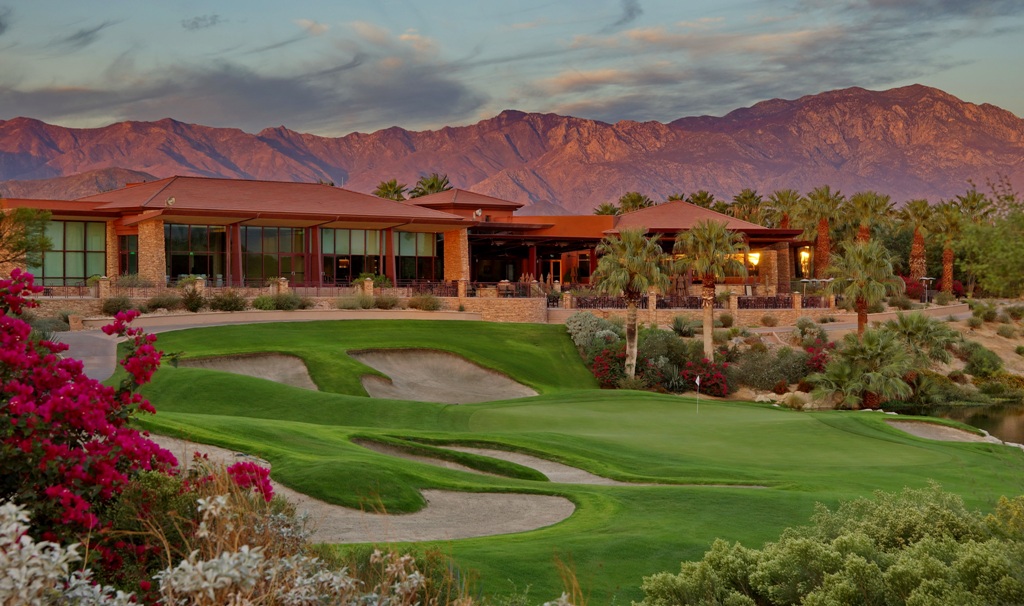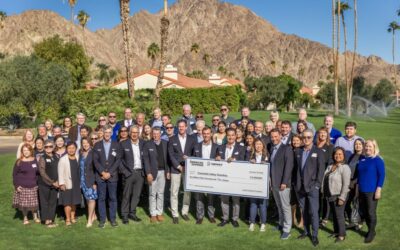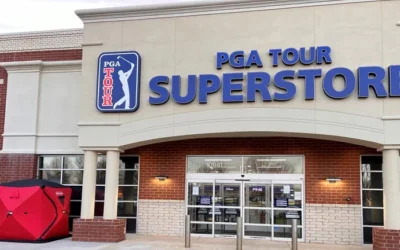At the beginning of 2020, golf courses in Greater Palm Springs, and nationwide, were experiencing business as usual. There was no indication then that it would turn out to be the biggest year ever for the industry.
The outlook changed drastically in the spring when everything came to a standstill because of the pandemic. But as we learned more about the coronavirus, it became clear: golf had the potential to serve as an ideal quarantine outlet.
The reasons why are fairly intuitive. We learned that being outdoors means a lower risk of transmission, and golf is entirely outdoors. We learned that keeping other people at a distance helps, too, and golf requires no real proximity. You can play golf alone, and you can play without ever going into a clubhouse. Golf course operators in Greater Palm Springs had reasons to be cautiously optimistic that if they were able to reopen, golfers would flock to the fairways. And the numbers show that’s what happened.
When California started reopening in late April and May, local golf courses were some of the first “safe” spaces that were able to get back to business as they effectively adapted their operations to accommodate customers, while adhering to CDC and Riverside County Health Department guidelines. The core principles to reopen safely included; stay six feet away from your playing partners, in the early months, only one rider per cart (that remains in some states/facilities); do not take the flag out when putting; do not use rakes in the bunkers; do not shake hands or high five playing partners; wear masks in public areas where groups might congregate; and some states required starting times stretch out to avoid crowds on the first tee before teeing off.
Additionally, there were relatively few events/outings, and golfers were encouraged not to linger within the pro shop or grill room; rather they should go outside where they could distance appropriately and generally not gather in groups.
“It’s almost as if the game of golf were invented to withstand a pandemic,” said Craig Kessler, Director of Government Affairs for the Southern California Golf Association (SCGA). “We were able to show public officials early on that in golf if you max out a golf course you have 1.3 people per acre of open space which makes it much safer than any of the other activities. And I give great credit to the courses for adapting so well. They get routinely inspected and have passed with flying colors.”
Increased interest in the sport quickly followed as people felt they would be safe at the course. In May, the number of reported rounds of golf in the United States – according to industry intelligence company, Golf Datatech – rebounded from a 42.2% decline during lockdowns to a 6.2% increase over 2019.
Then, rounds began to surge. In fact, the National Golf Foundation (NGF) reports there has only been one other year that saw a bigger rise in interest in the sport: 1997, the year Tiger Woods became a massive sensation.
“The surge in the golf business in Southern California has been rather stunning, and the industry is trying to figure out how to sustain it,” said Kessler. “In the desert area, much of this happened in the off season during an especially hot summer which is even more remarkable. New players are coming into the game, existing golfers are playing much more, and those who once played but left for a while are returning, which is the perfect combination to drive sales of rounds and equipment in a safe environment.”
Metrics of success
As spring shutdowns gave way to an unprecedented summer and fall in terms of play, golfer introductions and reintroductions, robust late-season spending bloomed. Looking back on an astonishing year, several things stand out in the macro view of the U.S. golf industry, including:
- 14% year-over-year increase in rounds played despite March/April course shutdowns,
- Total golf participation (on/off-course combined) up 8% to 36.9 million participants,
- Net gain of 500,000 on-course golfers, the largest boost in 17 years, up to 24.8 million, and
- Significant decrease in the number of course closures as the financial health of facilities nationwide has improved.
Referring to the net gain of 500,000 active golfers, Ralph Stokes, Director of Marketing for PGA TOUR Superstore (which operates a store in Palm Desert), points to the fact that 5.7 million people have stepped away from the game while 6.2 million entered or re-entered. “The loss of so many golfers during the same period when we added record numbers was marked by virus anxieties, financial hardships and parenting challenges, and the cancellation of thousands of charity and/or corporate events that draw in occasional golfers,” according to Stokes. “But we are optimistic about keeping a large portion of the new and re-engaged players while many of those impacted so adversely by the pandemic will be in a better position to come back to the game in the next couple years as the virus wanes.”
Stokes reports that the PGA TOUR Superstore in Palm Desert is one of the company’s top performers among the 45 stores it currently operates. Two new stores are slated to open soon in Boston and New York with a goal of having 50 stores open by the end of 2021.
“PGA TOUR Superstore sales were up 26% in 2020 compared to 2019 which had been our best year ever, and that’s with most stores being closed for eight weeks and many for up to 13 weeks,” added Stokes. “In 2019 golf ball sales were the best on record for us; in 2020 they were up an astounding 700%.”
Desert Willow Golf Resort in Palm Desert, a public facility owned by the City of Palm Desert and operated by Kemper Sports, broke their records for rounds played and overall revenue in 2020 after a very strong year in 2019. “From July on, we saw record numbers in terms of rounds played,” said Derek White, general manager. “We were up 30% in July, August was up 50%, and the fall was phenomenal. Through the end of November, rounds increased by 18% and revenue was up by 13%, and that is compared to a record year in these categories in 2019.”
White reports that through December, Desert Willow (which averages approximately 90,000 rounds per year) was still on a record pace for greens fees, although the stay-at-home order started to have a significant impact. “In January we saw a drop in rounds and revenue, largely because of the stay-at-home order which hurt us based on the lack of hotels accepting leisure travel visitors. But we’re looking forward to getting back on track as the order has been lifted and the drive market is picking up again.”
In another measure of success, Desert Willow sold out of their Platinum Club program, which is for high-volume, typically local players who get special benefits, including discounts for their guests. All of the 1,000 memberships were quickly sold for the coming year.
Private clubs feel the boost too
At the Club at PGA WEST in La Quinta, Jennifer Jenkins, director of membership sales and marketing reports that 2020 was a great year. “We experienced a huge boom in membership, especially in the fourth quarter, as people in Orange County, Los Angeles, Seattle, Portland and other major cities saw us as a safe haven and place to enjoy outdoor recreation, including our amazing golf courses,” she noted.
The Club at PGA WEST maintains approximately 1,500 memberships accounting for more than 3,000 people when including spouses and family members. Sales of memberships was up more than 20% in 2020 compared to 2019 and more robust than during the real estate boom of the early 2000s according to Jenkins.
A smart approach, as much as a rising tide, went into the successful recruitment of new members to PGA WEST. “When COVID first hit, a lot of clubs shut down their sales departments, but we continued,” said Jenkins. “We touched base with prospects, not really selling but staying in contact and just checking in. By the time the summer rolled around we saw a big change.”
A new sweet spot emerged as Jenkins and her team noticed that a lot of people who have owned second homes within the gates of PGA WEST for years but never looked at a membership, and maybe didn’t have the time for golf, suddenly were inquiring about it. “Some of these folks had been here five to ten years but never joined,” said Jenkins. “People we had been calling and mailing about deals for years have come in after we sent out some promotions to members encouraging them to invite their friends to consider joining. Golf became a hot ticket and we benefitted greatly from it.”
In recent years, the Club at PGA WEST has invested very substantially in upgrading their clubhouses, fitness and tennis/pickleball facilities and adding a wide range of amenities that have proven attractive to new members while making the current members very happy. All of this has added to the value proposition the Club offers. “It’s not just golf that was open and available, but we were able to keep tennis and pickleball going. It was about getting people outside and active, keeping as much of the club going as we could,” said Jenkins.
At The Hideaway Golf Club in La Quinta, membership sales roughly doubled in 2020 compared to 2019 even as the available real estate – lots and resales homes – was at historic lows. Alyssa Cicero, director of membership sales and marketing, says that most of the activity took place beginning at the end of May and continues strongly now. “As people sought a safe haven and a second or third home they could also work from, we saw a big increase in activity from people from greater Los Angeles and also from Portland and Seattle,” said Cicero. “We’ve seen a huge decrease in median age of our home buyers and new members too, which has been great, as people have found that golf has become one of the ways families spend time together.”
Is the surge sustainable?
When life returns to some semblance of normal, there will be significant pressure on many to return to the activities they gave up when the pandemic hit. Kid’s sports teams and leagues, watching and attending professional sports, college athletics, travel, vacations, etc., will demand attention that has shifted to golf while those other activities were off-limits.
Getting new golfers to stick around and keep playing has been the golf industry’s greatest challenge for quite some time. While it’s inevitable that some new golfers will return to their old activities, everyone in the industry is banking on the notion that many will stick around and keep teeing it up.
“We should be able to sustain much of it,” says Kessler. “In some ways, over time as golf participation was waning in past years, we denigrated the basic premise of why people love golf and why it has endured for 600 or more years. Now, through a pandemic people have discovered that pure golf played in a reasonable amount of time is a great pleasure. It’s a lesson for the industry to get back to promoting what’s fun and good about golf because there’s an immutable value of getting away from things and being out in nature walking and spending high-quality time with friends and family.”
Other activities will compete for time and money, but how much they take away from time spent golfing is an important issue for the industry. “We just don’t know what will happen when the vaccines reduce the incidence of the virus and all the other sports and activities become available again,” said Stokes. “How many did it for a fad but go back to their activities is obviously uncertain. But many of the 5.7 million who left the game will come back, and we think there will be more people staying with the game as the economy improves.”
Kemper Sports has created a task force to determine how they can best engage with the new players and keep them into it post pandemic. “For example, lesson revenue at our facility has been through the roof from summer until now,” said White. “So, not only are they buying equipment and getting out to the courses but they’re working on improving their skills which bodes well because we know that if they are taking lessons and getting better, they are more likely to stay with it.”
Perhaps it mostly will come down to an old adage shared by Kessler, “It’s eight times harder to get a new customer than keep an existing one. Maybe as golf’s new customers have played this past year, they’ve realized that there’s something about a walk in nature, in fresh air, with friends and/or family that is unique and special about golf and keep coming back for more.”
Photo credit: Scott Avra Photography




